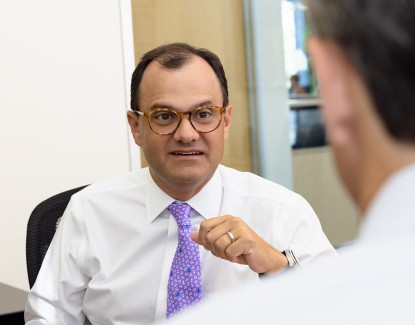Cyclical Businesses That Could Benefit from Lower Interest Rates
In the following commentary, the Portfolio Managers of the Hennessy Focus Fund (HFCSX/HFCIX) cover potential beneficiaries of rate cuts, their case for cyclical areas of the market, the Fund’s earnings growth rates and valuation, new holding Floor & Decor, and their outlook for the Fund.
-
 David Rainey, CFACo-Portfolio Manager
David Rainey, CFACo-Portfolio Manager -
 Brian Macauley, CFACo-Portfolio Manager
Brian Macauley, CFACo-Portfolio Manager -
 Ira Rothberg, CFACo-Portfolio Manager
Ira Rothberg, CFACo-Portfolio Manager
How might interest rate cuts affect the companies in the portfolio?
The markets are currently focused on 1 or 2 cuts in the fed funds rate although lower long-term interest rates may be more important to the businesses in the Hennessy Focus Fund portfolio.
We see three positive impacts as a result of rate cuts:
1. Lower rates may stimulate consumer demand for products and services, particularly in rate sensitive areas such as housing, autos, big ticket items, discretionary spending and even purchases on credit cards.
2. As a result, many businesses should see improving sales and operating leverage.
3. Valuations should increase. If longer term rates start to decline, that should lead to higher valuations for equities over time.
Are there any areas or sectors that look more attractive compared to a year ago?
The significant outperformance of the Magnificent Seven in the first half of 2024 has not had any notable impact on the companies we follow nor our investment approach. We are fairly systematic sorting through investment opportunities, and we continue that approach as we review new businesses.
The businesses we own that are more rate sensitive and/or cyclical have had a more difficult performance period than the general market. These include companies such as CarMax, RH, and Encore Capital. We believe these areas in the broader market are where the best opportunities lie—in those companies that have been left behind by the relatively strong market over the course of the last several quarters.
Going forward, our positive outlook is influenced by our belief that the headwind of interest rates is likely to turn into a tailwind, which could benefit some of these core holdings in our portfolio.
With over 50% of the portfolio allocated to the financial and consumer cyclical sectors, would you please share the investment case for these areas of the market?
All of the Fund’s holdings are selected on a bottom-up process and measured against our five key investment criteria. The companies must be a high-quality business with a large growth opportunity, excellent management, low “tail risk,” and purchased at a discount valuation.
Our Financial holdings are a diverse group of specialty finance businesses and not depositories. For example, Encore Capital is a debt collector, Markel Group is a property, casualty insurance company, Aon is a property, casualty brokerage company, and Brookfield Asset Management is an alternative asset manager. None of these companies are in the traditional business of lending.
As it relates to the consumer cyclicals, the Fund owns CarMax, O’Reilly Automotive, Floor & Decor, Hilton Worldwide Holdings, RH and NVR, many of which have been long-term holdings in the Fund. We believe these companies will benefit from lower rates as they should stimulate business and consumer demand.
What are the earnings growth rates and valuations of the Fund vs. the broad-based Russell 3000® Index as of 2Q 2024?
As of the beginning of the third quarter of 2024, the Fund offered a lower valuation with a higher expected growth rate versus the benchmark Index. The Fund’s expected 2025 earnings per share growth rate was 18.4% and the Fund was trading at a price-to-earnings (P/E) multiple of 17.2x. By comparison, the Russell 3000 Index, a proxy for the broad equity market, has earnings growth expectations of 15.5% with a P/E multiple of 19.6x.
Please share your investment thesis for the funds newest holding, Floor & Decor.
Floor & Decor is a chain store with a wide variety of flooring, backsplashes, sinks and more. Its leading market share of about 10% of the hard-surface flooring industry and direct sourcing model allow it to offer consumers and professional installers a better value proposition than the competition, resulting in a virtuous cycle of increasing market share, better buying power, and lower prices that it passes through to the consumers.
Floor & Decor is disrupting the hard-surface flooring industry by offering a best-in-class products assortment, the deepest in stock inventory, and lower prices. The average square feet per store of 78,000 is more than triple the size of specialty tile flooring companies and nearly 15x larger than the space dedicated to hard surface flooring at large home improvement centers.
Additionally, the number of in-stock SKUs (stock-keeping units) per store is unmatched. With a large inventory, the company can cut out agents, brokers, importers, and distributors and instead buy direct from the manufacturer. This approach reduces the cost and time to acquire inventory from suppliers.
The company offers much lower prices, usually a discount of 10% to 20% versus Home Depot and Lowe’s and often greater than a 60% discount compared to independent stores.
We believe the hard surface flooring market is insulated from online competition due to the bulk and weight of the products and the fact that customers prefer to see and touch the product before making a large purchase.
Demand for hard-surface flooring is also cyclically depressed, as housing turnover is about 30% below a normalized level. We model a base case 15% to 20% internal rate of return over the next seven years as the company grows from 225 warehouse stores to approximately 500 locations.
What is your outlook for the Fund?
Since the Fund’s holdings are predominantly a collection of what we believe to be high-quality secular growth businesses trading reasonable valuations, we continue to have a positive long-term outlook.
We expect the Fund’s returns to be determined primarily by the growth in earnings power of these businesses. Specifically, our expectation is for mid-teens annualized earnings growth for the portfolio over a 5-year horizon.
- In this article:
- Domestic Equity
- Focus Fund
You might also like
-
 Portfolio Perspective
Portfolio Perspective
Cornerstone Large Growth FundHigh Profitability and Attractive Valuations – A Compelling Combination
 Neil J. HennessyChief Market Strategist and Portfolio Manager
Neil J. HennessyChief Market Strategist and Portfolio Manager Ryan C. Kelley, CFAChief Investment Officer and Portfolio Manager
Ryan C. Kelley, CFAChief Investment Officer and Portfolio Manager L. Joshua Wein, CAIAPortfolio ManagerRead the Commentary
L. Joshua Wein, CAIAPortfolio ManagerRead the CommentaryIn the following commentary, the Portfolio Managers of the Hennessy Cornerstone Large Growth Fund discuss the Fund’s formula-based investment process and how it drives the Fund’s sector and industry positioning.
-
 Portfolio Perspective
Portfolio Perspective
Cornerstone Value FundDriven by Revenues, Cash Flow, and High Dividend Yields
 Neil J. HennessyChief Market Strategist and Portfolio Manager
Neil J. HennessyChief Market Strategist and Portfolio Manager Ryan C. Kelley, CFAChief Investment Officer and Portfolio Manager
Ryan C. Kelley, CFAChief Investment Officer and Portfolio Manager L. Joshua Wein, CAIAPortfolio ManagerRead the Commentary
L. Joshua Wein, CAIAPortfolio ManagerRead the CommentaryIn the following commentary, the Portfolio Managers of the Hennessy Cornerstone Value Fund discuss the Fund’s formula-based investment strategy and how it drives the Fund’s sector and industry positioning.
-
 Portfolio Perspective
Portfolio Perspective
Focus FundLong-term Investing in a Concentrated Collection of Businesses
 David Rainey, CFACo-Portfolio Manager
David Rainey, CFACo-Portfolio Manager Ira Rothberg, CFACo-Portfolio Manager
Ira Rothberg, CFACo-Portfolio Manager Brian Macauley, CFACo-Portfolio ManagerRead the Commentary
Brian Macauley, CFACo-Portfolio ManagerRead the CommentaryIn the following commentary, the Portfolio Managers of the Hennessy Focus Fund summarize the 2024 market and provide their insights on their 2025 outlook, including the impact on holdings from presidential administration’s policy changes and the growth of AI.
